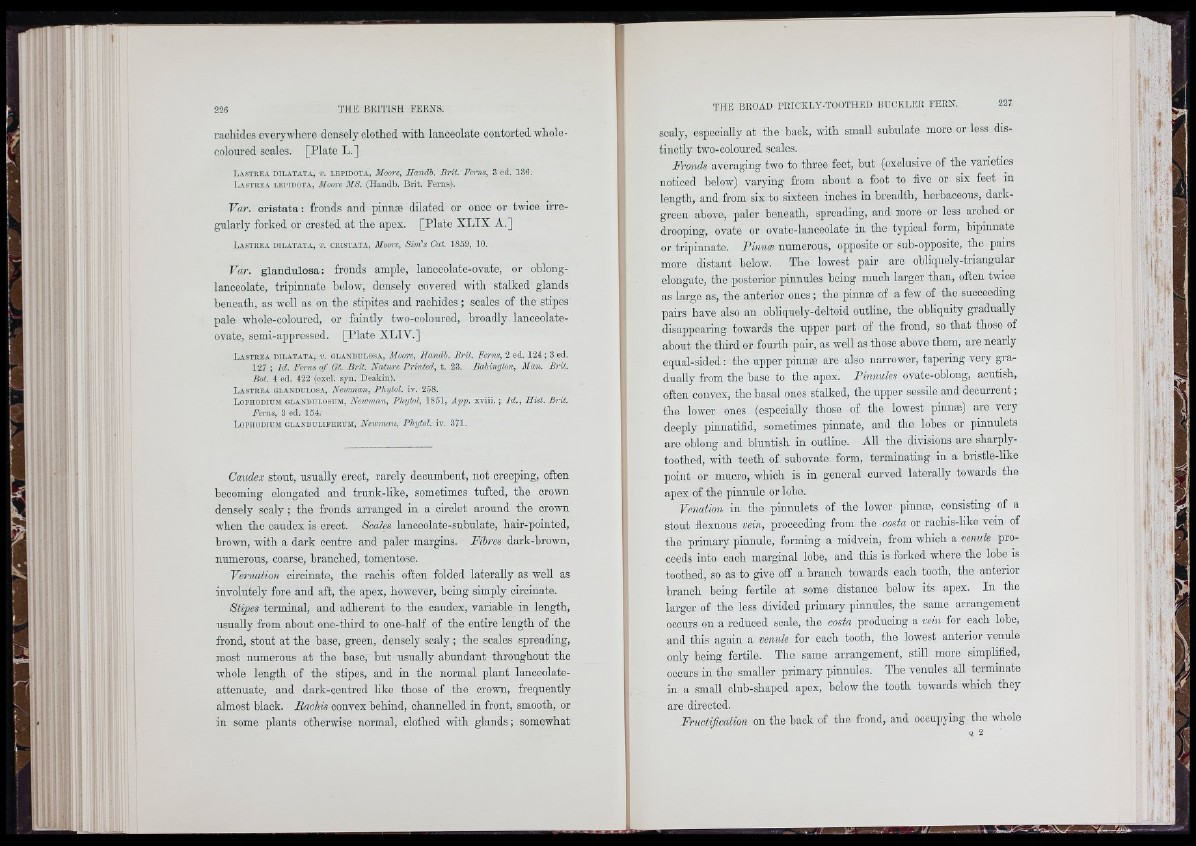
raohides every where densely clothed with lanceolate contorted whole-
coloured scales. [Plate L.]
L a st e ea d ila ta ta , v . l e pido ta , Moore, Ilandh, Brit. Fems, 3 ed. 136.
L a st e ea l e pido ta , Moore MS. (Handb. Brit. Ferns).
Var. c rista ta : fronds and pinnæ dilated or once or twice irregularly
forked or crested at the apex. [Plate XLIX A.]
L a st e ea d ila ta ta , ». c eista ta , Moore, Sim's Cat. 1859, 10.
Var. glandulosa; fronds ample, lanceolate-ovate, or oblong-
lanoeolate, tripinnate below, densely covered with stalked glands
beneath, as well as on the stipites and raohides ; scales of the stipes
pale whole-coloured, or faintly two-coloured, broadly lanceolate-
ovate, semi-appresscd. [Plate XLIV.]
L a.steea d ila ta ta , ». glandulosa, Moore, Handh. Brit. Ferns, 2 ed. 124; 3 ed.
127 ; Id. Ferns o f Gt. Brit. Nature Printed, t. 23. Babington, Alan. Brit.
Bot. 4 ed. 422 (excl. syn. Deakin).
L a str ea glandulosa, Newman, Phytol. iv. 258.
L o phodium glandulosum, Newman, Phytol, 1851, App. x v iii. ; Id ., Hist. Brit.
Ferns, 3 ed. 154.
L o phodium g la n d u l if er um , Ncwman, Phytol. iv. 371.
Caudex stout, usually erect, rarely decumbent, not creeping, often
heooming elongated and trunk-like, sometimes tufted, the crown
densely scaly ; the fronds arranged in a circlet around the crown
when the caudex is erect. Scales lanceolate-subulate, hair-pointed,
brown, with a dark centre and paler margins. Fibres dark-brown,
numerous, coarse, branched, tomentose.
Vernation circinate, the raohis often folded laterally as well as
involutely fore and aft, the apex, however, being simply circinate.
Stipes terminal, and adherent to the caudex, variable in length,
usually from about one-third to one-half of the entire length of the
frond, stout at the base, green, densely scaly ; the scales spreading,
most numerous at the base, but usually abundant throughout the
whole length of the stipes, and in the normal plant lanceolate-
attenuate, and dark-centred like those of the crown, frequently
almost black. Bachis convex behind, channelled in front, smooth, or
in some plants otherwise normal, clothed with glands ; somewhat
scaly, especially at the hack, with small subulate more or less distinctly
two-coloured scales.
Fronds averaging two to three feet, hut (exclusive of the varieties
noticed below) varying from about a foot to five or six feet in
length, and from six to sixteen inches in breadth, herbaceous, dark-
green above, paler beneath, spreading, and more or less arched or
drooping, ovate or ovate-lanoeolate in the typical form, bipinnate
or tripinnate. Binnai numerous, opposite or suh-opposite, the pairs
more distant below. Tho lowest pair aro obliqnely-triangular
elongate, the posterior pinnules being much larger than, often twice
as largo as, the anterior ones ; the pinnæ of a few of the succeeding
pairs have also an ohliquely-deltoid outline, the obliquity gradually
disappearing towards the upper part of the frond, so that thoso of
about the third or fourth pair, as well as those above them, are nearly
equal-sided ; the upper piimæ are also narrower, tapering very gradually
from the base to tho apex) Finnules ovate-oblong, aoutish,
often convex, the basal ones stalked, the upper sessile and decurrent ;
the lower ones (especially those of the lowest pinnæ) are very
deeply pinnatifid, sometimes pinnate, and the lobes or pinnulets
are oblong and bluntish in outline. All the divisions are sharply-
toothed, with teeth of subovate form, terminating in a bristle-like
point or mucro, which is in general curved laterally towards the
apex of the pinnule or lobe.
Venation in the pinnulets of the lower pinnæ, consisting of a
stout flexuous vein, proceeding from the costa or raohis-like vein of
the primary pinnule, forming a midvoin, from which a venule proceeds
into each marginal lobe, and this is forked where the lobe is
toothed, so as to give off a branch towards each tooth, the anterior
branch being fertile at some distance below its apex. In the
larger of the loss divided primary pinnules, the same arrangement
occurs on a reduced scale, the costa producing a vein for each lobe,
and this again a venule for each tooth, the lowest anterior venule
only being fertile. The same arrangement, still more simplified,
occurs in the smaller primary pinnules. The vonules all terminate
in a small club-shaped apex, below the tooth towards which they
are directed.
Fructification on the hack of the frond, and occupying tho whole
« 2
.'•r